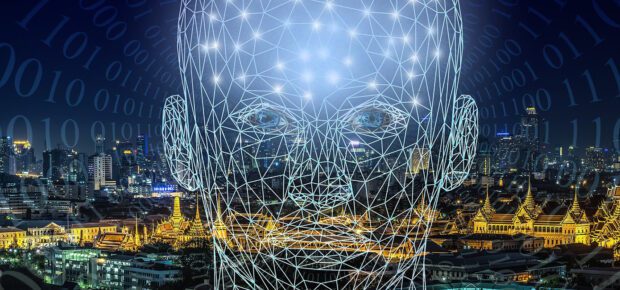December 29, 2022
When it comes to artificial intelligence, generative AI tools dominate the public’s attention. But even before those tools became widely available, artificial intelligence was making inroads all around us.
The fact is that artificial intelligence is all around us.
It’s used to help screen for cancer, fight poaching of endangered elephants and to detect archeological ruins from space. But AI isn’t limited to the frontiers of science. In fact, artificial intelligence is everywhere, and it has been for years.
“AI technologies are penetrating nearly every aspect of our lives, almost imperceptibly,” said Guangjie Han, IEEE Fellow. “It powers our devices while continuously improving by analyzing data we produce on those devices.”
Common uses include:
- Generative AI: Since generative AI systems became widely available to the public their use has grown significantly. Nearly one out of three people surveyed said that they used it daily or at least once per week, according to a survey by the St. Louis Federal Reserve. Generative AI tools can create words, images and videos in response to prompts. These capabilities have been applied to a number of domains, from developing marketing copy to serving as tutors.
- Voice Assistants: Efforts to get computers to understand speech began in the 1950s, but progress was slow for decades. By the late 1990s, the rise of the internet, faster data speeds and the accompanying rise in available data led to the ability to train speech recognition systems with far more data than had been possible. Neural network technology, a form of artificial intelligence, began revolutionizing automatic speech recognition in the 2000s, leading to the development of smart speakers and voice assistants in the 2010s. Today, voice assistants are embedded in nearly every electronic device, including our cars.
- Smart Home Devices: The idea of home automation has been around for decades. The first programmable thermostat, which relied on a mechanical clock, hit the market in 1906. It allowed homeowners to adjust the temperature (and save heating costs) throughout the day, turning down the heat when the house was unoccupied, and turning it up when people were home. When thermostats went digital, programming soon followed there as well. The next step was the so-called smart device, one that could learn your preferences over time, using artificial intelligence, no programming required.
Today, a range of smart devices are available, such as those to water the garden or adjust lighting. Smart cameras can also alert consumers to the presence of people, cars or packages.
- Recommender Systems: When you browse your favorite streaming service, why does the service show you some movies and not others? It’s usually the result of a recommender system, which has become integral to e-commerce and digital entertainment over the past few years.
A recommendation system helps users avoid information overload by filtering content based on user preferences. The system uses what it knows about you, what it knows about other users and a healthy dose of machine learning to help you find new books to read, music to listen to or pants to buy.
- Trend Identification in Retail: The fashion industry changes rapidly. Items that fly off the shelves one day may be difficult to sell the next. The speed at which trends change makes it risky to chase them. By the time a retailer has spotted a trend, designed a product, manufactured and shipped it, fickle consumers may have moved on to the next hot item. Enter artificial intelligence. Retailers are mining social media, using natural language processing, to spot trends when they are on the rise. They are also using image analysis to identify what people are wearing. These methods allow designers to get a jump on trends and manufacture items so that they are in stores when the public wants them.
- Navigation and Travel: Paper maps are now largely relics of the past, as artificial intelligence has fundamentally reshaped how we navigate our world. AI-powered systems, whether through smartphone apps or integrated vehicle dashboards, guide the journeys of billions of travellers every day, relying on real-time data like road closures and speed limits to calculate the fastest, most fuel-efficient use. Artificial intelligence is also used to construct maps, integrating satellite imagery with other data points to produce more comprehensive and up-to-date maps.
- Facial Recognition to Unlock Phones: Unlocking a smartphone with a simple glance is a modern convenience that many have quickly adopted. This seemingly effortless interaction is the result of sophisticated artificial intelligence embedded within the device. With advanced camera and sensor technology, the AI constructs a precise biometric map of the user’s face, capturing unique features and contours. The development of these systems represents a significant application of AI in everyday consumer electronics, relying on machine learning models. They can also adapt to subtle changes in appearance over time.
- Financial Fraud Detection: AI is extremely good at pattern analysis, and it turns out that most of us use credit cards in a fairly predictable way. That makes artificial intelligence well-suited for the task of determining which credit card transactions may be illicit. Nearly every time a purchase is made with a credit card, that transaction is subject to a real-time analysis that tries to determine if the purchase is legitimate. The fraud detection systems develop models of a customer’s typical shopping behavior. When a transaction seems unusual, it can trigger a fraud investigation. If you’ve ever gotten a call from your bank asking if you made a transaction, that was likely the result of AI.
- Autocomplete and predictive text: Like many AI technologies, the history of autocomplete has non-AI roots. The first autocomplete and predictive text technologies arose out of efforts to develop keyboards for the Chinese language. Western computing caught up nearly 50 years later. The first predictive text systems for Western tech matched typed text with dictionaries of words. So, typing the word “astro” would bring up words like astronomy or astronomical. Today, they use artificial intelligence to understand the context of what users are working on or looking for. In search engines, autocomplete functions might look at recent search history to clarify meanings.
- Autocorrect: The earliest autocorrect systems relied on hard-coded lists of common errors that people made. Computers would check the words a user typed against that list, changing words that matched the list. The system left a lot to be desired, and it often missed words that were spelled correctly but weren’t appropriate for the context, like “they’re,” “their” and “there” in English. Next came the development of statistical systems which offered a solid improvement. They categorized spelling and grammar errors, and offered users multiple choices for potential errors that the system was able to detect. Artificial intelligence systems developed to understand the context of language use and correct errors based on that context.
For the foreseeable future, much of the effort in AI systems will focus on building larger, and less biased, data sets on which to train the models.
“AI needs to be explainable,” said IEEE Fellow Karen Panetta. “For example, many companies are selling products that evaluate people’s performance and determine compensation. And yet the decisions coming out of these systems cannot be explained as to how the AI determined that outcome. AI should not impact someone’s livelihood.”
Learn more: Artificial intelligence is all around us, and that means designers of AI systems need to think about the impact it has on users. The IEEE Standards Association provides guidelines on the development of empathic and ethical artificial intelligence.





 Liquid Infrastructure: Our Planet's Most Precious Resource
Liquid Infrastructure: Our Planet's Most Precious Resource The Impact of Technology in 2025
The Impact of Technology in 2025 Quantum and AI: Safeguards or Threats to Cybersecurity?
Quantum and AI: Safeguards or Threats to Cybersecurity? Why AI Can't Live Without Us
Why AI Can't Live Without Us Bits, Bytes, Buildings and Bridges: Digital-Driven Infrastructure
Bits, Bytes, Buildings and Bridges: Digital-Driven Infrastructure Impact of Technology in 2024
Impact of Technology in 2024 Emerging AI Cybersecurity Challenges and Solutions
Emerging AI Cybersecurity Challenges and Solutions The Skies are Unlimited
The Skies are Unlimited Smart Cities 2030: How Tech is Reshaping Urbanscapes
Smart Cities 2030: How Tech is Reshaping Urbanscapes Impact of Technology 2023
Impact of Technology 2023 Cybersecurity for Life-Changing Innovations
Cybersecurity for Life-Changing Innovations Smarter Wearables Healthier Life
Smarter Wearables Healthier Life Infrastructure In Motion
Infrastructure In Motion The Impact of Tech in 2022 and Beyond
The Impact of Tech in 2022 and Beyond Cybersecurity, Technology and Protecting Our World
Cybersecurity, Technology and Protecting Our World How Technology Helps us Understand Our Health and Wellness
How Technology Helps us Understand Our Health and Wellness The Resilience of Humanity
The Resilience of Humanity Harnessing and Sustaining our Natural Resources
Harnessing and Sustaining our Natural Resources Creating Healthy Spaces Through Technology
Creating Healthy Spaces Through Technology Exceptional Infrastructure Challenges, Technology and Humanity
Exceptional Infrastructure Challenges, Technology and Humanity The Global Impact of IEEE's 802 Standards
The Global Impact of IEEE's 802 Standards Scenes of our Cyber Lives: The Security Threats and Technology Solutions Protecting Us
Scenes of our Cyber Lives: The Security Threats and Technology Solutions Protecting Us How Millennial Parents are Embracing Health and Wellness Technologies for Their Generation Alpha Kids
How Millennial Parents are Embracing Health and Wellness Technologies for Their Generation Alpha Kids Space Exploration, Technology and Our Lives
Space Exploration, Technology and Our Lives Global Innovation and the Environment
Global Innovation and the Environment How Technology, Privacy and Security are Changing Each Other (And Us)
How Technology, Privacy and Security are Changing Each Other (And Us) Find us in booth 31506, LVCC South Hall 3 and experience the Technology Moon Walk
Find us in booth 31506, LVCC South Hall 3 and experience the Technology Moon Walk Virtual and Mixed Reality
Virtual and Mixed Reality How Robots are Improving our Health
How Robots are Improving our Health IEEE Experts and the Robots They are Teaching
IEEE Experts and the Robots They are Teaching See how millennial parents around the world see AI impacting the lives of their tech-infused offspring
See how millennial parents around the world see AI impacting the lives of their tech-infused offspring Take the journey from farm to table and learn how IoT will help us reach the rising demand for food production
Take the journey from farm to table and learn how IoT will help us reach the rising demand for food production Watch technical experts discuss the latest cyber threats
Watch technical experts discuss the latest cyber threats Explore how researchers, teachers, explorers, healthcare and medical professionals use immersive technologies
Explore how researchers, teachers, explorers, healthcare and medical professionals use immersive technologies Follow the timeline to see how Generation AI will be impacted by technology
Follow the timeline to see how Generation AI will be impacted by technology Learn how your IoT data can be used by experiencing a day in a connected life
Learn how your IoT data can be used by experiencing a day in a connected life Listen to technical experts discuss the biggest security threats today
Listen to technical experts discuss the biggest security threats today See how tech has influenced and evolved with the Games
See how tech has influenced and evolved with the Games Enter our virtual home to explore the IoT (Internet of Things) technologies
Enter our virtual home to explore the IoT (Internet of Things) technologies Explore an interactive map showcasing exciting innovations in robotics
Explore an interactive map showcasing exciting innovations in robotics Interactively explore A.I. in recent Hollywood movies
Interactively explore A.I. in recent Hollywood movies Get immersed in technologies that will improve patients' lives
Get immersed in technologies that will improve patients' lives